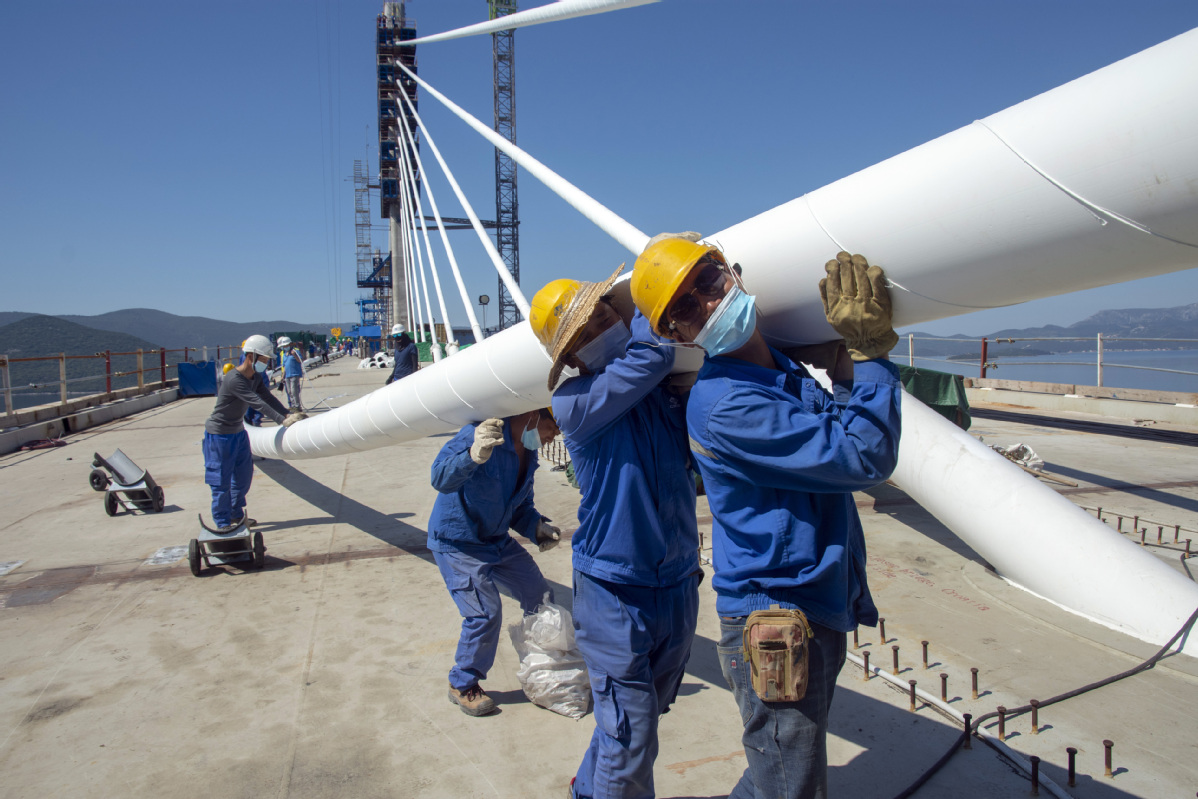CRBC ramps up business abroad


Nation's nonfinancial outbound direct-investment rose to $71.02 billion in the first eight months
With its port, railway, bridge and highway projects completed and running smoothly in Pakistan, Kenya, Serbia and Kyrgyzstan in recent years, China Road and Bridge Corp, a Beijing-based State-owned enterprise, will transform into an industry chain builder by continuing to innovate diversified ownership mechanism and business modes across the world in the coming years.
While many countries are taking stimulus packages to help sustain economic momentum and mitigate the impact caused by the COVID-19 pandemic, the company has been expanding its business scope by participating in individual projects such as innovating various cooperative modes including engineering, procurement and construction, public-private projects and build-operate-transfer deals in overseas markets this year.
Based on its experience from its operation and maintenance projects including the Mombasa-Nairobi Standard Gauge Railway in Kenya and the TT & AMT Expressways in Senegal, the company will focus on big-ticket projects like the Phnom Penh-Sihanoukville Expressway to support its growth at the next level, said Wang Lijun, CRBC's vice-president.
The $2 billion expressway connects Phnom Penh, capital of Cambodia, and the deep-sea port province of Preah Sihanouk in the country's southwest. It is scheduled to be completed and begin operations in September 2022.
As opposed to monetary measures, higher investment in the infrastructure sector is a practical way to deal with the economic slowdown and stimulate manufacturing activities. It can also help regain economic vitality, Wang said. In addition to narrowing the gap between landlocked areas and coastal countries and regions, this brings more benefits to local residents.
Besides completing the first mass concrete pouring of the main tower bearing platform of Cocodi Bridge project in Cote d'Ivoire, and opening the Estrella-Pantaleon Bridge to traffic in the Philippines, CRBC has also constructed the Peljesac Bridge in Croatia.
Croatian Prime Minister Andrej Plenkovic attended a ceremony with locals marking the connection of the bridge on July 29. The project is a tangible example to boost local economies through reliable supply chains of Chinese firms and beneficial localization.
The Peljesac Bridge is located in Komarna, a tourist region in southern Croatia. The economy of the village relies mainly on the flourishing summer tourism season. Generally, the village goes quiet after tourists leave in winter. Fortunately, the Peljesac Bridge project changes the situation, as a continuous stream of project personnel brings locals plenty of opportunities.
The bridge marks key infrastructure, as it will connect the Peljesac Peninsula in Dubrovnik-Neretva county, the southernmost Croatian county, with the mainland of the country.
It means the Croatians will not have to bypass the Neum Corridor, a piece of Bosnia and Herzegovina's territory that divides the Croatian county into two parts, in order to travel to Dubrovnik by road. The three-hour one-way journey will be cut to two to three minutes.
Croatia has been mulling over the idea of a Peljesac Bridge for almost two decades, according to locals. The project began in 2018 after CRBC won the bid and adopted European Union standards and accepted EU funds. The project is regarded as a breakthrough in China-Croatia cooperation and an example of China-Croatia-EU cooperation.
As an iconic infrastructure project funded by the EU, the bridge is 3,940 meters long, with a 2,440-meter main body and a 22.5-meter-wide deck.
In order to fight against the impact of the COVID-19 pandemic, the Chinese company arranged a direct charter flight for its welders to get the building work back on schedule.
Over the past three years, CRBC said the business unit of this project had established cooperation with a total of 111 professional companies, retained 54 local engineers, external liaison officers and translators, and trained a considerable number of local infrastructure management professionals. Seven foreign engineers were awarded the engineer certificate by the Croatian Association of Civil Engineers in July, becoming professional engineers.
Josipa Pavlic, a 29-year-old Chinese-English-Croatian trilingual translator for the project, said the building work for the bridge uses practices of a localized management mode, with its management team composed of both Chinese and Croatian members.
"The project also engages a dozen local professional subcontractors in such fields as technical consulting, concrete supply, geological surveying, measuring and testing. The project has created many jobs for locals," Pavlic said.
The Peljesac Bridge project also showed that major infrastructure can have a limited impact on local ecosystems if the highest environmental standards are practiced. The main environmental challenges of the project are preserving local oyster farms while shielding dolphins in the surrounding waters from construction noise.
Niksa Orlandic, a Croatian environmental engineer with the project, said engineers with CRBC managed to have only a slight impact when using pile drivers thanks to the use of noise-canceling technology.
"The construction of the bridge had no negative effect on the aquaculture of the bay, which is known for oyster farming and whitefish breeding," Orlandic said.
Apart from entrusting local supervising companies to oversee quality control and environmental protection issues, CRBC hired Croatian law firms and consulting companies in order to adapt to EU regulations regarding infrastructure projects.
CRBC's businesses are mainly engaged in project contracting and investment, development and operation in fields such as roads, bridges, ports, railways, airports, real estate and industrial parks. It has established branches in nearly 60 countries and regions around the world.
Continued foreign and domestic investment in infrastructure such as ports, bridges and roads will be key elements in supporting economic growth in many developing economies, especially those participating in the Belt and Road Initiative, at least over the next decade. They will create better conditions to stimulate trade and people-to-people exchanges in these BRI-related markets, said Zhang Liqun, a researcher with the Development Research Center of the State Council.
Over the long run, countries in many parts of the world will not only speed up investment in the development of traditional infrastructure categories such as railroads and regional airport construction, but also add resources to public health services, 5G networks and cutting-edge manufacturing technologies amid efforts to place their economic growth on a firmer footing during the post-pandemic era, Zhang said.
China's nonfinancial outbound direct investment rose 3.7 percent on a yearly basis to $71.02 billion in the first eight months, the Ministry of Commerce said. In the January-August period, nonfinancial direct investment into countries and regions involved in the BRI soared 9.2 percent year-on-year to $12.89 billion, accounting for 18.1 percent of total nonfinancial ODI by Chinese firms.




































